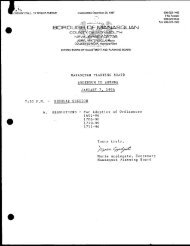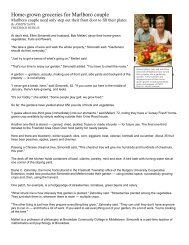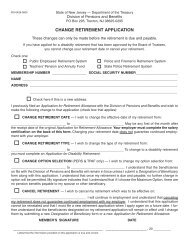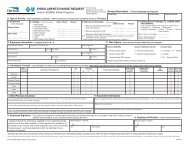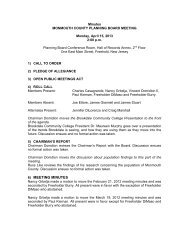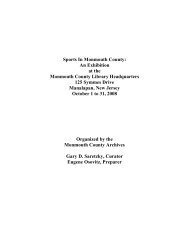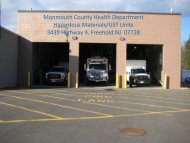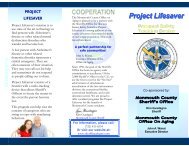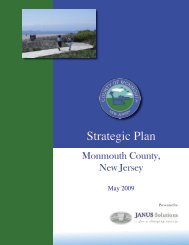NATURAL and CULTURAL FEATURES of MONMOUTH COUNTY
NATURAL and CULTURAL FEATURES of MONMOUTH COUNTY
NATURAL and CULTURAL FEATURES of MONMOUTH COUNTY
You also want an ePaper? Increase the reach of your titles
YUMPU automatically turns print PDFs into web optimized ePapers that Google loves.
2004 in the County - 3162 single <strong>and</strong> multi-family units; more than 50% were built in Ocean <strong>and</strong><br />
Manalapan townships (MCPB, 2005c).<br />
The greatest rate <strong>of</strong> population growth in Monmouth County was when it more than doubled<br />
between 1950 <strong>and</strong> 1970, following the post war boom <strong>and</strong> the opening <strong>of</strong> the Garden State<br />
Parkway in 1954, from 225,337 in 1950 to 461,489 in 1970 (MCPBb, 2005). It increased by 9%<br />
from 1970 to 1980, 10% from 1980 to 1990, <strong>and</strong> 11% from 1995 to 2005 (MCPBb, 2005).<br />
During the boom years <strong>of</strong> 1950-1970, almost 50% <strong>of</strong> the population growth occurred within 3<br />
miles <strong>of</strong> the Parkway; since 1990, much <strong>of</strong> the growth takes place in western Monmouth, in<br />
Howell (16%), Marlboro (14%), Freehold Township (11%), <strong>and</strong> Manalapan (11%) (MCPBb,<br />
2005). The MCPB’s analysis <strong>of</strong> vacant l<strong>and</strong>, development trends <strong>and</strong> current zoning predicts a<br />
0.5% increase in population growth per year for the County, from the current estimate <strong>of</strong><br />
645,349, reaching 697,071 in 2025 (MCPBb, 2005).<br />
In 2004, more than 60% <strong>of</strong> the new single family units were found in western Monmouth, while<br />
65% <strong>of</strong> the multi-family units were found in the coastal region (MCPB, 2005c). According to the<br />
2000 Census, homes valued under $100,000 accounted for only 6.7% <strong>of</strong> the County’s housing<br />
stock, while homes valued over $300,000 accounted for 24.9% (MCPBb, 2005). In 2004, there<br />
were 343 new single family development homes built that were worth more than $1 million,<br />
about a 76% increase over 2003 (MCPBb, 2005). The County was third in NJ for issuance <strong>of</strong><br />
2,628 residential building permits in 2004, but second in terms <strong>of</strong> total value <strong>of</strong> residential<br />
development, at $410,856,945; Manalapan, Howell, Middletown, Upper Freehold <strong>and</strong> Marlboro<br />
issued the most single family permits in 2004 (MCPBb, 2005). Proposed residential activity is<br />
near a 15 year high (MCPBb, 2005). The municipalities with the greatest amount <strong>of</strong> the 207 non<br />
residential site plans that were submitted to the MCPB in 2004 were Upper Freehold (32%),<br />
Freehold Township (16%), Wall (11%), Tinton Falls (10%), Howell (5%) <strong>and</strong> Middletown (4%)<br />
(MCPBb, 2005). Industry in the County is small, only 24 million square feet compared to 36<br />
million in Somerset <strong>and</strong> 98 million on Rt. 287 near the NJ Turnpike (MCPBb, 2005). There are<br />
3 enclosed malls, as well as Monmouth Park Raceway, the PNC Arts Center, <strong>and</strong> Wall Stadium.<br />
The top 5 employers in Monmouth County as <strong>of</strong> 2005 are: Meridian Health Systems (7500),<br />
Fort Monmouth (5500), AT&T (4050),Monmouth County (3607), Foodarama (2458) (MCPBa,<br />
2005). Ft. Monmouth accounts for 5500 workers, 5000 <strong>of</strong> which are private contractors; Naval<br />
Weapons Station Earle provides 1500 jobs (MCPBb, 2005). In 2005, Fort Monmouth, the 2 nd<br />
major employer in the County, announced it will be closing its base, <strong>and</strong> in 2006, Lucent<br />
Industries, the 11 th top employer, announced it was selling its facility in Holmdel.<br />
As <strong>of</strong> 1990, there were a total <strong>of</strong> 274,238 commuters; almost 65 % <strong>of</strong> commuters worked within<br />
the County, 25% commuted to other New Jersey counties, <strong>and</strong> almost 10% commuted to New<br />
York State. In 2002, the number <strong>of</strong> vehicles reported as owned were: none: 12,538; three or<br />
more: 51,619; one: 63,816; two: 96,952 (MCPB, 2005; MCDEDT, 2005). Between 1990 <strong>and</strong><br />
2000, the number <strong>of</strong> County residents working in Staten Isl<strong>and</strong> rose by 35.7%, in Brooklyn by<br />
36.4%, <strong>and</strong> Manhattan by 17.7% (MCPBb, 2005). Of the 286,271 (2000) workers 16 years or<br />
older who commute, about 85% drive, <strong>and</strong> <strong>of</strong> those 243,943 drivers, only about 10% carpool<br />
(MCPBb, 2005). Of the 22,061 who take public transportation, about 55% are bus riders, 31%<br />
take the train, <strong>and</strong> 4% take ferries; 7,654, or 2.7% <strong>of</strong> the total workers, work at home, a bit more<br />
than those who walk to work (6,672) (MCPBb, 2005). A report in 2006 by the Tri-State<br />
Transportation Campaign found that between 1997 <strong>and</strong> 2004 found that about 1 in 10 NJ




